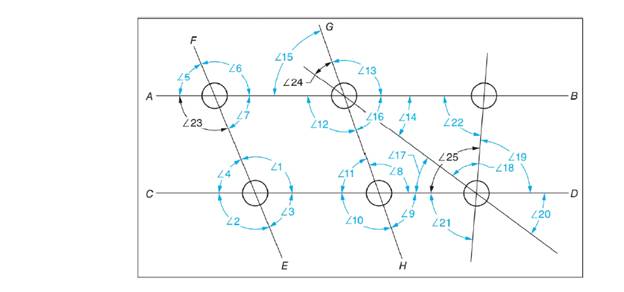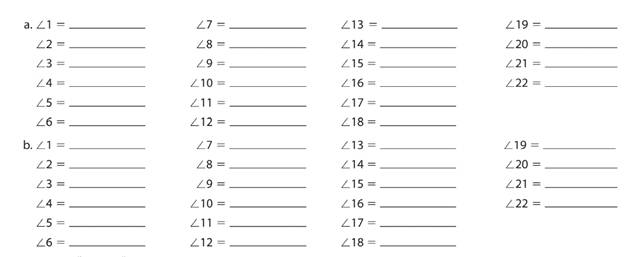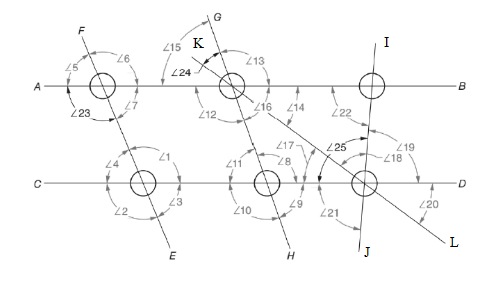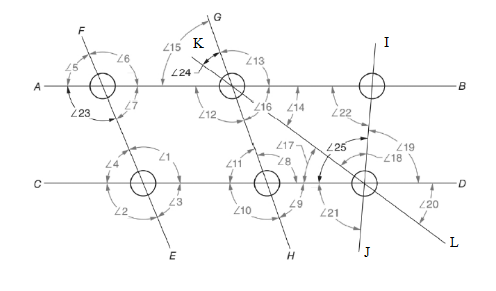
Given: Hole centrelines
a.
b.


(a)
The values of angles
Answer to Problem 16A
The values of angles are
Explanation of Solution
Given:
The given value of angles is
The following figure is given

The angles
Now, angle 6 and angle 5 together make a straight line. The angle of straight line is 180o. Thus, the value of angle 5 can be calculated as
The angles
The two lines AB and CD are parallel; hence the corresponding angles will be equal. Hence,
The two lines EF and GH are also parallel; hence the corresponding angles will be equal. Hence,
The two lines AB and CD are parallel; hence the corresponding angles will be equal. Hence,
Now, angle 25 and angle 21 together make a straight line. The angle of straight line is 180o. Thus, the value of angle 21 can be calculated as
The angle 21 and 22 are corresponding angles, thus, the value of angle 22 is
The angles 22 and 19 are interior alternate angles for the parallel lines AB and CD. The alternate angles are equal.
The value of angle 14 can be calculated by subtracting the value of angle 24 from the angle 15.
The lines AB, KH and IJ make a triangle. The sum of internal angles of a triangle is 180o.
Now,
Angle 20 and angle 17 are opposite angles.
(b)
The values of angles
Answer to Problem 16A
The values of angles are
Explanation of Solution
Given:
The given value of angles is
The following figure is given

The angles
Now, angle 6 and angle 5 together make a straight line. The angle of straight line is 180o. Thus, the value of angle 5 can be calculated as
The angles
The two lines AB and CD are parallel; hence the corresponding angles will be equal. Hence,
The two lines EF and GH are also parallel; hence the corresponding angles will be equal. Hence,
The two lines AB and CD are parallel; hence the corresponding angles will be equal. Hence,
Now, angle 25 and angle 21 together make a straight line. The angle of straight line is 180o. Thus, the value of angle 21 can be calculated as
The angle 21 and 22 are corresponding angles, thus, the value of angle 22 is
The angles 22 and 19 are interior alternate angles for the parallel lines AB and CD. The alternate angles are equal.
The value of angle 14 can be calculated by subtracting the value of angle 24 from the angle 15.
The lines AB, KH and IJ make a triangle. The sum of internal angles of a triangle is 180o.
Now,
Angle 20 and angle 17 are opposite angles.
Want to see more full solutions like this?
Chapter 52 Solutions
Mathematics For Machine Technology
- Find all solutions of the polynomial congruence x²+4x+1 = 0 (mod 143). (The solutions of the congruence x² + 4x+1=0 (mod 11) are x = 3,4 (mod 11) and the solutions of the congruence x² +4x+1 = 0 (mod 13) are x = 2,7 (mod 13).)arrow_forwardDetermine whether each function is an injection and determine whether each is a surjection.The notation Z_(n) refers to the set {0,1,2,...,n-1}. For example, Z_(4)={0,1,2,3}. f: Z_(6) -> Z_(6) defined by f(x)=x^(2)+4(mod6). g: Z_(5) -> Z_(5) defined by g(x)=x^(2)-11(mod5). h: Z*Z -> Z defined by h(x,y)=x+2y. j: R-{3} -> R defined by j(x)=(4x)/(x-3).arrow_forwardDetermine whether each function is an injection and determine whether each is a surjection.arrow_forward
- Let A = {a, b, c, d}, B = {a,b,c}, and C = {s, t, u,v}. Draw an arrow diagram of a function for each of the following descriptions. If no such function exists, briefly explain why. (a) A function f : AC whose range is the set C. (b) A function g: BC whose range is the set C. (c) A function g: BC that is injective. (d) A function j : A → C that is not bijective.arrow_forwardLet f:R->R be defined by f(x)=x^(3)+5.(a) Determine if f is injective. why?(b) Determine if f is surjective. why?(c) Based upon (a) and (b), is f bijective? why?arrow_forwardLet f:R->R be defined by f(x)=x^(3)+5.(a) Determine if f is injective.(b) Determine if f is surjective. (c) Based upon (a) and (b), is f bijective?arrow_forward
- 1 S 0 sin(lnx) x² - 1 Inx dxarrow_forward2 6. Modelling. Suppose that we have two tanks (A and B) between which a mixture of brine flows. Tank A contains 200 liters of water in which 50 kilograms of salt has been dissolved and Tank B contains 100 liters of pure water. Water containing 1kg of salt per liter is pumped into Tank A at the rate of 5 liters per minute. Brine mixture is pumped into Tank A from Tank B at the rate of 3 liters per minute and brine mixture is pumped from Tank A into Tank B at the rate of 8 liters per minute. Brine is drained from Tank B at a rate of 5 liters per minute. (a) Draw and carefully label a picture of the situation, including both tanks and the flow of brine between them. JankA 1ks of Salt Slits Pump EL Brine mit tark A from tank 13 Tank 13 k 3L zooliters of Ico liters of water with pure water. Saky salt → 777 disslore inside Brine mix is pumped from tank A to B of 82 Brine drainen min by Gf salt (b) Assume all brine mixtures are well-stirred. If we let t be the time in minutes, let x(t) 1ks…arrow_forwardNo chatgpt plsarrow_forward
 Mathematics For Machine TechnologyAdvanced MathISBN:9781337798310Author:Peterson, John.Publisher:Cengage Learning,
Mathematics For Machine TechnologyAdvanced MathISBN:9781337798310Author:Peterson, John.Publisher:Cengage Learning, Trigonometry (MindTap Course List)TrigonometryISBN:9781305652224Author:Charles P. McKeague, Mark D. TurnerPublisher:Cengage Learning
Trigonometry (MindTap Course List)TrigonometryISBN:9781305652224Author:Charles P. McKeague, Mark D. TurnerPublisher:Cengage Learning Holt Mcdougal Larson Pre-algebra: Student Edition...AlgebraISBN:9780547587776Author:HOLT MCDOUGALPublisher:HOLT MCDOUGAL
Holt Mcdougal Larson Pre-algebra: Student Edition...AlgebraISBN:9780547587776Author:HOLT MCDOUGALPublisher:HOLT MCDOUGAL- Algebra & Trigonometry with Analytic GeometryAlgebraISBN:9781133382119Author:SwokowskiPublisher:Cengage
 Elementary Geometry For College Students, 7eGeometryISBN:9781337614085Author:Alexander, Daniel C.; Koeberlein, Geralyn M.Publisher:Cengage,
Elementary Geometry For College Students, 7eGeometryISBN:9781337614085Author:Alexander, Daniel C.; Koeberlein, Geralyn M.Publisher:Cengage, Elementary Geometry for College StudentsGeometryISBN:9781285195698Author:Daniel C. Alexander, Geralyn M. KoeberleinPublisher:Cengage Learning
Elementary Geometry for College StudentsGeometryISBN:9781285195698Author:Daniel C. Alexander, Geralyn M. KoeberleinPublisher:Cengage Learning





